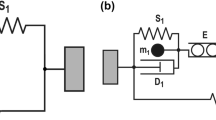Abstract
The objective of this study was to use nonlinear identification techniques to study the dynamics of stretch reflexes in the human calf muscles (gastrocnemius-soleus). Stochastic perturbations of ankle position were applied while subjects maintained a constant, tonic contraction of gastrocnemius-soleus. Linear models of the relation between ankle velocity and the electromyographic (EMG) activity under these conditions typically accounted for less than 40% of the observed EMG variance. Nonlinear system identification techniques were then applied. The first- and second-order Wiener kernels were computed as the initial stage of this analysis. These did not provide an adequate description of system behavior; subsequent simulation studies showed that the major problem with the Wiener analysis was that the input spectrum was not adequately white. Nevertheless, the shape of the second-order Wiener kernel suggested that a Hammerstein structure consisting of a static nonlinearity followed by a dynamic linear system would be appropriate. Consequently, we used an iterative procedure for Hammerstein system identification to determine the form of the static nonlinearity and the associated linear dynamics. The resulting nonlinear model provided a much better description of the system's behavior than did the linear models (variance accounted for>60%). Furthermore, they confirmed our previous empirical findings; the static nonlinearity closely resembled a half-wave rectifier while the dynamics were typified by a pure delay and a velocity filter. The application of nonlinear identification techniques thus produced a much improved, physically meaningful model of stretch reflex behavior.
Similar content being viewed by others
References
Billings, S.A. Identification of nonlinear systems: a survey. IEEE Proc. 127:272–285; 1980.
Eykhoff, P. System identification: Parameter and state estimation. London: Wiley; 1974.
Houk, J.C.; Rymer, W.Z. Neural control of muscle length and tension. In: Brooks, V.B., ed. Handbook of physiology. Section 1: The nervous system. Volume II. Motor control, Part 1. Bethesda, MD: American Physiological Society; 1981:257–323.
Hunter, I.W.; Kearney, R.E. Generation of random sequences with jointly specified probability density and autocorrelation functions. Biol. Cybern. 47:141–146; 1983.
Hunter, I.W.; Kearney, R.E. NEXUS: A computer language for physiological systems and signal analysis. Comp. Biol. Med. 14:385–401; 1984.
Hunter, I.W.; Korenberg, M.J. The identification of nonlinear biological systems: Wiener and Hammerstein cascade models. Biol. Cybern. 55:135–144; 1986.
Kearney, R.E.; Hunter, I.W. System identification of human triceps surae stretch reflex dynamics. Exp. Brain Res. 51:117–127, 1983.
Kearney, R.E.; Hunter, I.W. System identification of human stretch reflexes: Tibialis anterior. Exp. Brain Res. 56:40–49; 1984.
Korenberg, M.J. Statistical identification of Volterra kernels of high order systems. IEEE Int. SCS 2:570–575; 1984.
Korenberg, M. Functional expansions, parallel cascades and nonlinear difference equations. In: Marmarelis, V.Z., ed. Advanced methods of physiological system modeling. Los Angeles: Biomedical Simulations Resource, University of Southern California; 1987: 221–240.
Leontaritis, I.J.; Billings, S.A. Input-output parametric models for nonlinear systems. Int. J. Cont. 41:303–344; 1985.
Liddell, E.G.; Sherrington, C. Reflexes in response to stretch (myotatic reflexes). Proc. Roy. Soc. B. 96:212–242; 1924.
Marmarelis, V.Z., editor. Advanced methods of physiological system modeling. Los Angles: Biomedical Simulations Resource, University of Southern California; 1987.
Marmarelis, P.Z.; Marmarelis, V.Z. Analysis of physiological systems: the white-noise approach. New York: Plenum Press; 1978.
Matthews, P.B.C. Mammalian muscle receptors and their central actions. Baltimore: Williams & Wilkins; 1972.
Rugh, W.J. Nonlinear system theory: The Volterra/Wiener approach. Baltimore: Johns Hopkins University Press; 1981.
Author information
Authors and Affiliations
Rights and permissions
About this article
Cite this article
Kearney, R.E., Hunter, I.W. Nonlinear identification of stretch reflex dynamics. Ann Biomed Eng 16, 79–94 (1988). https://doi.org/10.1007/BF02367382
Issue Date:
DOI: https://doi.org/10.1007/BF02367382




